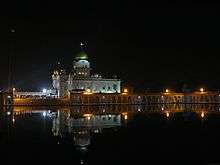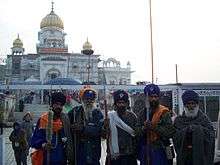Gurudwara Bangla Sahib
Gurudwara Bangla Sahib (![]()
| Gurudwara Bangla Sahib | |
|---|---|
 Gurudwara Bangla Sahib as viewed from Main Entrance. 
| |
| Religion | |
| Affiliation | Sikhism |
| Location | |
| Location | Connaught Place, New Delhi, India. |
| Architecture | |
| Style | Sikh architecture |
| Completed | 1664 as a bungalow, again rebuilt in 1783, current structure mostly built post 1947 |
It is situated near Connaught Place, New Delhi on Baba Kharak Singh Marg and it is instantly recognisable by its golden dome and tall flagpole, Nishan Sahib.[2] Located next to it is the Sacred Heart Cathedral.
History

Gurdwara Bangla Sahib was originally a bungalow belonging to Raja Jai Singh, an Indian ruler in the seventeenth century, and was known as Jaisinghpura Palace, in Jaisingh Pura, an historic neighbourhood demolished to make way for the Connaught Place, shopping district.[3]
The eighth Sikh Guru, Guru Har Krishan resided here during his stay in Delhi in 1664. During that time, there was a smallpox and cholera epidemic, and Guru Har Krishan Ji helped the suffering by giving aid and fresh water from the well at this house. Soon he too contracted the illness and eventually died on 30 March 1664. A small tank was later constructed by Raja Jai Singh over the well, its water is now revered as having healing properties and is taken by Sikhs throughout the world back to their homes.
The Gurdwara and its Sarovar are now a place of great reverence for Sikhs, and a place for special congregation on birth anniversary of Guru Har Krishan.
Overview

The grounds include the Gurudwara, a kitchen, a large (holy) pond, a school, and an art gallery. As with all Sikh Gurdwaras, the concept of langar is practised, and all people, regardless of race or religion may eat in the Gurdwara kitchen (langar hall). The Langar (food) is prepared by gursikhs who work there and also by volunteers who like to help out. At the Gurdwara, visitors are requested to cover their hair and not to wear shoes. Assistance to foreigners and visitors with Guides, head scarves, and shoe-minding service can be found inside the compound and are available free of charge. Anyone can volunteer to help keep the shoes in the shoe-minding room, and cleaning the precincts of the Gurudwara.
The complex also houses a higher secondary school, Baba Baghel Singh Museum, a library, and a hospital. The Gurudwara and the langar hall are now air-conditioned. A new "Yatri Niwas" (travellers hostel), and multi-level parking space have been constructed. Toilet facilities are available. The space around the back entrance to the Gurudwara is also being spruced up, so as to give a better view from the roadside.

References
- "Gurdwara Bangla Sahib - Delhi Gurdwara Bangla Sahib - Banglasahib Gurduwara New Delhi". www.bharatonline.com.
- "Bangla Sahib - Gurdwara Bangla Sahib Delhi, Bangla Sahib Gurudwara New Delhi India". www.iloveindia.com.
- Roy, Sidhartha (1 September 2011). "A tale of two cities". Hindustan Times. Archived from the original on 2 July 2015. Retrieved 27 April 2018.
External links
![]()